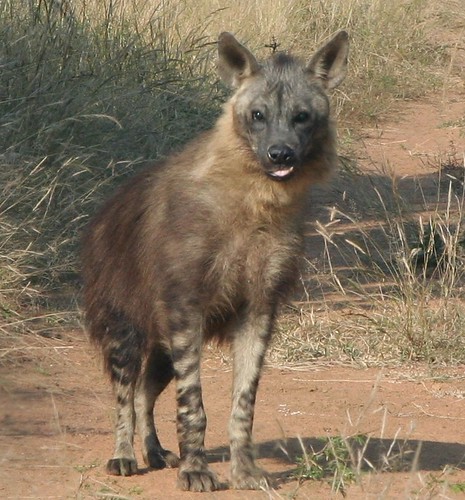Scientific Classification
- Kingdom: Animalia
- Phylum: Chordata
- Class: Mammalia
- Order: Carnivora
- Family: Hyaenidae
- Genus: Hyaena
- Species: H. brunnea
Sub Species
No subspecies of the Brown Hyena have been classified.
Related Animals
Closely related species include the spotted hyena (Crocuta crocuta), striped hyena (Hyaena hyaena), and the aardwolf (Proteles cristata).
Key Information
- Population Size: Approximately 5,000 – 8,000 individuals
- Lifespan: Up to 20 years in the wild
- Top Speed: 30 mph (48 km/h)
- Weight: Males 40–43.7 kg (88–96 lb); Females 37.7–40 kg (83–88 lb)
- Height: About 80 cm (31.5 in) at the shoulder
- Length: 130–160 cm (51–63 in)
- Coloration: Dark brown to near black
Geological Location & Range
Predominantly found in southern Africa, including Namibia, Botswana, South Africa, and parts of Zimbabwe and Mozambique.
Habitat
Brown hyenas are primarily desert-dwelling but can be found in various habitats, from grasslands to woodland savannas, mountainous areas, and coastal areas.
Biome
Savanna, Desert, Temperate Grassland, Coastal
Climate Zone
Tropical and Subtropical
Grouping Behavior
Brown hyenas are primarily solitary but can form clans of up to 10-14 members, usually consisting of related individuals. These clans are matriarchal.
Reproduction Information
- Age of Sexual Maturity: Around 2.5 – 3 years
- Name of Males: Male
- Name of Females: Female
- Name of Young/Offspring: Cub
- Reproduction Season: Non-seasonal
- Gestation Period: Approximately 90 days
- Type of Birth: Viviparous
- Age of Weaning: Approximately 12 months
Conservation Status
The International Union for Conservation of Nature (IUCN) lists the Brown Hyena as “Near Threatened.
General Description
Brown hyenas are scruffy-looking, dog-like carnivores known for their unique scavenging habits and nocturnal lifestyle. They have strong jaws, and a distinctive mane, and are found mainly in southern Africa.
Appearance
Brown hyenas have long, shaggy dark brown fur with a slightly lighter mane running down their back. They have pointed ears, strong jaws, and their back slopes towards their tail.
Geographical Distribution
Brown hyenas are distributed across the southern regions of Africa, with a significant presence in the arid areas of Namibia, Botswana, and parts of South Africa.
Habit and Lifestyle
Brown hyenas are primarily solitary, nocturnal creatures, though they live in clans. They forage alone and are known to cover large distances for food.
Diet and Nutrition
Brown hyenas are primarily scavengers and feed on carcasses. They also consume insects, and fruits, and occasionally hunt small mammals, birds, and reptiles.
Mating Habits
Brown hyenas mate throughout the year, with males from outside the clan often invited by females. Males do not stay with the females after mating and have no role in raising the cubs.
Population
Brown hyena populations are in decline, with estimates suggesting between 5,000 and 8,000 remaining. They face threats from habitat loss, human-wildlife conflict, and indirect poisoning. They play a critical role in their ecosystems by cleaning up carrion and controlling pest populations.
Interesting Facts
- Brown hyenas are remarkably able to digest all parts of a carcass, including bones and hooves.
- Unlike most mammals, female brown hyenas are generally larger and more dominant than males.
- Brown hyenas communicate with each other using a variety of vocalizations, postures, and scent markings.
AZA Zoos
As of the latest records, the following AZA-accredited zoos have Brown Hyenas:
- Dallas Zoo, Texas
- San Diego Zoo, California
- Bronx Zoo, New York
- Cincinnati Zoo & Botanical Garden, Ohio
Please contact the individual zoos for the most recent and accurate information.


